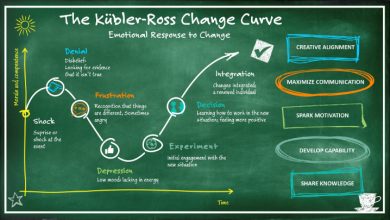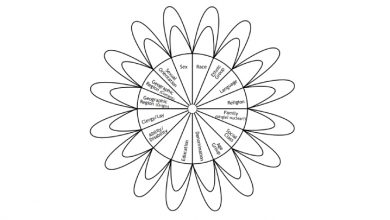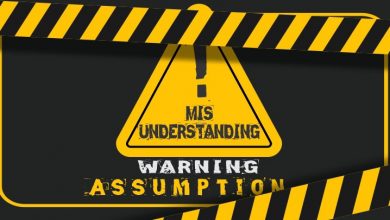Walking boldly into uncertainty and change
The desire to know, to be certain, is a completely natural human need. And yet there are times when we simply don’t know, or when what we think we know it isn’t accurate or reliable. If we develop the competence to embrace these times rather then trying to shut them down prematurely, the magic of genuine learning, having a paradigm shift and achieving a better result than we have in the past can take place.

Why did I choose this tool? Accepting ambiguity and change has always been a challenge for me. The desire to be right and to be certain has definitely dominated a portion of my life and at times still does. However, as a trainer and as a person I have come to see that the greatest breakthroughs I have experienced were when I didn’t hold on to what I knew or what I thought to be right, but I opened myself to a new possibility. These new possibilities and breakthroughs have made up who I am today, and I don’t even want to imagine what my life would have been like if I had held onto what I knew and refused to embrace the changes in me and around me.
How does this apply to being a trainer? As trainers we are asking participants to think outside of the box, to challenge their prejudices, to open themselves to learning, to consider and to listen rather than shut down on the first sign of disagreement or confusion. This is asking a lot, and for someone who is not practiced in doing so, it can be scary at first. If they sense that we do the same ourselves, that we are open, that we embrace ambiguity and change rather then shut it down in discomfort, it can give them courage and empower them to do the same.
Main content:
The wording of the competence “reflecting an acceptance of ambiguity and change” seems to imply that ambiguity and change are similar. But are they really?
Daniel Lock made an interesting differentiation between the two in an interview for Process Excellence Network (PEX).
PEX Network: Why do we hate change so much?
Daniel Lock: Well, I don’t know that we necessarily hate it that much. People change on a regular basis all the time. We get married, we have children, we move houses, and so on. I think what you’re asking me in the context of organizational change is why do people resist change so much and I think the reason for that is not so much that people hate change – they can usually sign up to the big bright light, the vision, and end result – but what they hate is the ambiguity. It’s the path on the way there that people have such a problem with.
It seems more accurate to say that positive change is, in fact, desirable to most people, while the difficult part is the uncertainty and ambiguity that we need to go through in order to reach the desired change.
This is why so many people will tell you that they want their lives to be different in some way, but when you ask them what they are actually doing to get there you will mostly hear excuses and reasons why they can’t do it. We tend to want the result without going through the process, like wanting to be thin and fit without working out or eating healthy.
The point in getting better at dealing with ambiguity is not so that we can be in or create ambiguity just for the sake of being ambiguous. It isn’t helpful or productive to continuously be in a state of ambiguity and not to be certain about anything.
Becoming more competent at dealing with ambiguity is only essential because it can bring us a better end result then what we would get if we didn’t face the ambiguity at all or if we shut it down too soon.
Check out this Ted Talk by Joshua Bailey, particularly from 6:00 until the end as he describes how struggled with the uncertainty but didn’t run away from it until he achieved the result he wanted.
Tony Robbins says “the quality of your life is determined by the amount of ambiguity you can comfortably handle”.
To raise the quality of something that already exists or to create something new, whether it be a training, a career, a relationship, public speaking or any other skill, a certain amount of ambiguity and uncertainty will be present on the path we have to take to get there.
In his book “The Deep Change Field Guide” Robert E. Quinn goes as far as to say that the alternative to change is a slow death.
Slow death begins when someone, confronting the dilemma of having to make deep organizational change or accepting the status quo, rejects the option for the deep change. This decision results in the gradual (and occasionally not so gradual) disintegration of an organization, business, or industry.
Albert Einstein went as far as to say that not changing what we’re doing or how we’re doing it, and yet expecting different results, can lead to incredible frustration and border on insanity.
“The definition of insanity is doing the same thing over and over again, but expecting different results.” – Albert Einstein
It seems pretty clear that over the course of our lives and in our work, the only way to improve ourselves and the results that we are getting is to learn how to handle and even be comfortable with the ambiguity and uncertainty that it will inevitably bring. If we like the results we are getting, of course, we don’t have to change and can stay the same. But as Robert E. Quinn describes above, there comes a time (or many times), for a person or an organization, when the alternative to change is becoming obsolete.
“In a world of change, the learners shall inherit the earth, while the learned will find themselves equipped for a world that no longer exists.” – Eric Hoffman
You might be thinking, ok I got it. Change is good, ambiguity is necessary. But how do I do it? How do I deal with the paralysis that uncertainty brings? How can I become more competent in handling ambiguity? How can I get to the point of not fearing change and ambiguity, but rather walking boldly into it?
Here are some steps compiled from research, my experience and the experience of others:
- Remind yourself why you’re doing it
Your goal has to be important enough to you to give you the courage to go through the process. If you don’t feel any courage coming from reminding yourself of this, this goal may be less important to you then you think. Is your potential future relationship with that girl worth the uncertainty of asking her out on a date? Is progress in your career worth the uncertainty of searching a long time for the right job? Is the learning of participants worth the ambiguity you need to deal with throughout the training process?
2. Remind yourself of past successes
Give yourself confidence to go through ambiguity by remembering all the times when you were confused and uncertain, and yet achieved a positive outcome. What about that time when you changed your career path, started a new relationship, gave a great speech or training, even cooked a fantastic meal without a recipe? How confused were you? How uncertain? And yet, how did you feel about the outcome you achieved?
3. Learn all you can, without paralyzing
You can decrease some of the ambiguity by learning what you can about the direction that you want to go in. What have other people experienced in the same situation? What can you find out about the company, the new country or the career path you are headed for? Learning is very useful as long as you keep it focused on what you need and make sure to implement it. Don’t go into “analysis paralysis” where you try to figure out everything in advance. No matter how much information you acquire, you’ll never be able to predict your outcome with 100% accuracy. Learn as much as you think you need, then just start doing and learn the rest on the go.
4. Ask for support
Having support from friends, colleagues, family or even our extended network can go a long way in giving us the bit of stability that we need to handle the uncertainty. Admitting that you’re confused or uncertain about something opens the door for other people to offer insights you may have missed, or even just to tell you that they’re there for you and supporting you through this time. Don’t make the mistake of expecting them to take the uncertainty away from you, as this can either leave you disappointed or misled. Just admit how you feel and let them support you in whatever way they can, with the knowledge that you have to deal with the uncertainty yourself.
5. Allow yourself to “fail”
One of the main reasons we want to be certain is because we want to avoid “failure” at all costs. The only way never to “fail” is never to try to do or be anything new, and that can lead to a much greater “failure” and loss in the long run. Appreciate yourself for stepping out and changing something, and accept that even if you “fail” the fact that you did something differently is its own success, as you will inevitably gain from the experience. Any other success that you get as a result of it is just an added bonus.
6. Be certain about something
Being in a state of uncertainty and ambiguity about everything will certainly paralyze you. Decide what things you are certain about. Is it your values? Your goals? Your relationship? Your family? Your job? Your financial stability? Your talents and skills? Being certain about some things gives you the foundation that you need to face the uncertain things, and reassures you that the chaos is limited to one or a few aspects of your life and not your entire life. Build what is uncertain on the foundation of what is certain, and don’t try to change everything at once.
7. Enjoy the process
Change, transformation and personal growth are important topics, but taking them too seriously doesn’t help. Avoid using terms like “should” and “have to” as they imply that you are in a straight jacket and have no choice in the matter. Instead use terms like “will” and “want to” and “am excited about” as they will help you to see what you’re going through from a positive perspective, inevitably changing how you feel about it. Make sure you make time to relax, to have fun and to laugh even if it’s at your own mistakes. Being serious and rigid will hinder the process, being relaxed and happy will move it forward.
Reflection questions:
Ask yourself in what areas of your life you might be resisting change, and how your quality of life/work may be going down as a result (or simply not improving). Then decide what steps you will take to start the change process.
Whenever you feel overwhelmed or paralyzed by ambiguity and change, spend some time coaching yourself through it by reviewing the steps in this article. Do it as many times as you need until you start to feel better and more confident to move forward.
- Remind yourself why you’re doing it
- Remind yourself of past successes
- Learn all you can, without paralyzing
- Ask for support
- Allow yourself to fail
- Be certain about something
- Enjoy the process





